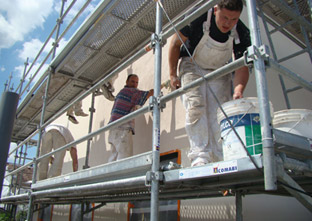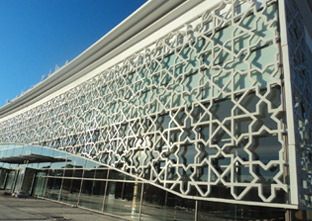
Plastics- a concrete case for construction
A little given in a heart of stone
Lost since the fall of Rome and until being re-discovered in the early 19th century, the formulation of cement - 80% limestone to 20% clay, ushered in a big success story for concrete.
Valued for its malleability, it was the making of "artificial stone," durable and strong once moulded into blocks, piping and even statuary...before pioneering architects and engineers won it its design credentials.
Thereafter, its rise in popularity was unstoppable, even by the excesses of ‘concrete brutalism’! The demands of urban development mean that concrete remains, by far, the king of construction materials.
Other cement products have also proved invaluable, especially as interfacing materials: cement adhesives, fixing mortars, grouting cement, rendering mortar, etc.

All these cementitious products are now factory-formulated by a complex chemical process in which organic polymers are a key component. These low-profile, high-performance plastics have opened up hitherto unimaginable technical possibilities.
Plastics toughen up concrete
 Concrete is no longer an aesthetic shock but a marvel in the landscape. The training regime to get there started fifteen years ago with slimming down, strenuous exercise...And a muscle-bulking course of polymer treatment! "Superplasticizers" (polyacrylates and polycarboxylates) give muscle definition, while skeletons are strengthened by replacing the old reinforcements with glass, metal or polymer microfibres.
Concrete is no longer an aesthetic shock but a marvel in the landscape. The training regime to get there started fifteen years ago with slimming down, strenuous exercise...And a muscle-bulking course of polymer treatment! "Superplasticizers" (polyacrylates and polycarboxylates) give muscle definition, while skeletons are strengthened by replacing the old reinforcements with glass, metal or polymer microfibres.
The result is ‘ultra high performance fibre-reinforced concrete’, UHPFRC to its friends, a constructional performer whose award-winning achievements include the Millau Viaduct in France and the concrete latticework of Rabat airport.
 Much less porous, thanks to plastic additives and with strong new microfibre reinforcements (50 million per m3), UHPFRC has six to eight times the mechanical strength of conventional concrete.
Much less porous, thanks to plastic additives and with strong new microfibre reinforcements (50 million per m3), UHPFRC has six to eight times the mechanical strength of conventional concrete.
Another advantage is that these "superplasticizer" polymers, even though sparingly added,less than 5%, considerably lighten the composition and hence environmental impact of concrete, enabling buildings to be constructed with a quarter of the volume using less aggregate (-25%) and cement (-33%).
Resource-sparing and a licence for inventiveness they may be, but these bespoke concrete solutions are not yet within the reach of all building projects. Fortunately, more affordable and standardized solutions are hitting the market.
Polymers light up concrete
While some strive to lighten concrete for more streamlined architectural forms, others dream of making it a semitransparent material. Amazingly, their shape-shifting fantasy has materialized.
Will Wittig of the University of Detroit-Mercy developed innovative translucent concrete panels, 2.5 mm thick, incorporating glass fibres - which are fine for decoration but less useful for load-bearing structures!
Hungarian architect Aron Losonczi had more success with his "LiTraCon" which combines concrete with optical fibres allowing light to be transmitted through blocks 20 cm thick. In the process, his company even developed a low-cost variant using plastic granules.

 Favouring a mixed solution, the Austrian company Luccon has meanwhile developed a high-performance translucent concrete combining optical fibres and BASF’s polymers.
Favouring a mixed solution, the Austrian company Luccon has meanwhile developed a high-performance translucent concrete combining optical fibres and BASF’s polymers.
The Italcementi Group has taken a different tack, using only thermoplastic resins to develop the translucent concrete facades of the Italian Pavilion at the 2010 Shanghai World Expo, designed by architect Giampaolo Imbrighi.
The most recent off-the-wall development is Chronos Chromos Concrete, a real visual display screen developed by design students at London’s Royal College of Art. The cellular concrete matrix embedded with thermosensitive polymers and electronic connections can change colours and display patterns, numbers and text.
Coming soon - recycled plastic in concrete
 A key material in development, concrete is a blessingfor some but a blight for others, that is spreading at a rate of 6 billion m3 a year. Whence the interest in solutions to lessen its environmental impact: excessive energy, water and mineral resource consumption and CO2 emissions.
A key material in development, concrete is a blessingfor some but a blight for others, that is spreading at a rate of 6 billion m3 a year. Whence the interest in solutions to lessen its environmental impact: excessive energy, water and mineral resource consumption and CO2 emissions.
One option being looked at, for example, is replacing concrete aggregates with recycled materials to reduce the mineral filler with no loss of strength. Working to that end, researchers at the Slovak Academy of Sciences have recently tested the addition of plastics from used electronic equipment.
Analysis of the physical behaviour of different mixtures overcame the first hurdle: the failure of the over-smooth recycled plastic granules to bond with the cement paste. A preliminary surface treatment now enables up to 25%, by weight, to be incorporated in the mix.
The in-situ durability of these recycled plastic-based concretes still have to be studied. If the tests are successful, then they could become a viable alternative means of reclaiming 15% of waste electrical and electronic equipment.






